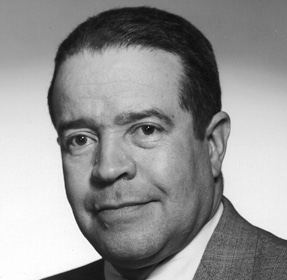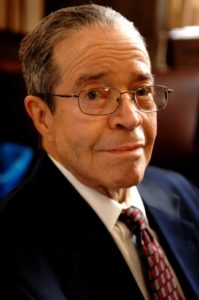
J. Ernest Wilkins Jr. was not only young and gifted, he was Black. By age 16 the university awarded Wilkins a bachelor’s degree in mathematics. By 17 he received his master’s, and by the age of 19, Wilkins completed his doctorate, a stunning achievement.
The American government was equally impressed, especially since the country was in the midst of World War II and wanted the brightest scientific minds to help develop its atomic energy and weapons capacities. A year after receiving his Ph.D., while teaching at the Tuskegee Institute in Alabama, Wilkins was recruited by the government to return to the University of Chicago, now the home of the world’s first nuclear reactor. In this capacity, Wilkins researched neutron energy while working in the preliminary stages of the Manhattan Project, the program producing the first nuclear weapons, with world-renowned scientists Eugene Wigner and Enrico Fermi. Within his first year, the 21-year-old discovered three scientific effects impacting the motion of subatomic particles now named for him, the Wilkins effect, the Wilkins epectra and the Wigner-Wilkins spectra.
“He was a very famous mathematician, not only to the Black community, but in general,” said Ronald Mickens, a physics professor and former colleague at Clark Atlanta University, where Wilkins taught mathematics from 1990 to 2003. “I had read a lot about him and, then, in my 20s, I met him,” Mickens said, characterizing him as “a superb mathematician.”
“In spite of the fact he could have passed for white if he wanted to, he always maintained the fact that he was Black,” noted Mickens.

“He was not stopped from going to Oak Ridge,” said Mickens, referencing a common misconception that Wilkins was disallowed from transferring to the Tennessee site to continue his atomic research. Wilkins, clarified Mickens, “was the one who decided that he was not going to live in that segregated community, so they found him something else to do.”
When it came to racism, one needs to understand, continued Mickens, that “people of that generation said, ‘I am going to succeed independently of these other conditions,’ and racism was just part of those conditions.”
“There’s a deep stoicism that runs through particularly the male side of my family,” explained Carolyn Marie Wilkins, Wilkins’ niece and a professor at the Berklee College of Music in Boston. A jazz singer and author, Carolyn penned “Damn Near White: An African American Family’s Rise from Slavery to Bittersweet Success,” a 2010 book on her accomplished family. “They are very upright, they’re very stoic, they do not complain, they don’t make excuses, they don’t whine, they keep their feelings to themselves.”
While thousands of scientists and researchers contributed to the Manhattan Project under J. Robert Oppenheimer, the “father of the atomic bomb” who coordinated the national effort, Mickens pointed out “there were a number of Blacks who were involved at a high level, all of them brilliant.” Among them was Carolyn Beatrice Parker, who worked as a physicist to produce polonium as part of the construction of the first atomic bombs. A mathematician from Fisk University with a master’s from the University of Michigan, Parker went on after the war to earn a second master’s degree in physics at the Massachusetts Institute of Technology before succumbing at age 47 to a form of leukemia associated with her polonium work.
There were also the Knox brothers who contributed to the Manhattan Project while working as chemists at Columbia University; Fisk University’s Samuel P. Massie Jr., who worked as a project chemist at Iowa State University’s Ames Laboratory; Howard University’s Harold Delaney, a project chemist at the University of Chicago’s Metallurgical Laboratory (Met Lab); Lincoln University’s George Sherman Carter, a project physicist at Columbia; Jasper Jeffries, a project physicist at Met Lab; and Edwin Russell, Harold Evans, George Warren Reed, Lloyd Quarterman, Moddie Taylor, Benjamin Franklin Scott and Blanche J. Lawrence, who all worked as project chemists at Met Lab.

After the war Wilkins, like many African-American scientists, wished to join the faculty at a major university, but few, if any, would accommodate, especially considering it was the mid-1940s and the armed forces had yet to be desegregated. Instead, he began a career in the private sector while earning a bachelor’s and master’s in mechanical engineering at New York University. Wilkins eventually landed a position with the Nuclear Development Corporation of America, where he helped design a power-generating nuclear reactor and, for years, researched and introduced other peaceful applications for nuclear energy.
In the 1970s, while teaching at Howard University and creating its mathematics Ph.D. program, Wilkins served as president of the American Nuclear Society from 1974 to 1975. A year later, Wilkins became the second African-American elected to the prestigious National Academy of Engineering for his design and development of nuclear reactors in the peaceful application of atomic energy. Mickens noted that “most of his work, for a long time, was nonmilitary.”
Mickens, who had stayed in touch over the years through academic circles and professional events, would eventually recruit Wilkins to teach math and physics at Clark Atlanta in 1990, where the two conducted joint research and became good friends. In 2003, Wilkins ended his lengthy career at Clark, having published well over 100 scientific papers and earned numerous fellowships and honors in mathematics, physics and engineering. He died eight years later at age 87, leaving behind an extraordinary legacy of success and achievement in science, mathematics and research, one that racism could not cripple.
“You either survive or you don’t survive, but you don’t get anything done by worrying about it,” Mickens said of the can-do attitude that Wilkins embodied despite both the legal and daily discrimination he faced. “You worry about it only in the sense that you want to change it, but you don’t let it stop you.”


